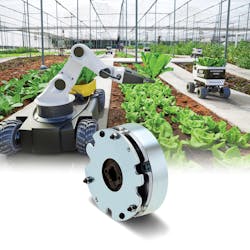Agricultural Autonomous Guided Vehicles Utilize Latest Miki Pulley Brakes For Efficient And Positive Positioning Control
Autonomous Guided Vehicles (AGV) for agricultural applications are being developed at a record pace. The labor-saving potential employing these vehicles is huge. These vehicles provide opportunity for automating many agricultural functions including seeding, fertilizing, weeding and harvesting operations.
An important key to the successful use of this AGV technology is efficient and positive positioning control of the AGV vehicle and its robotic arm. To achieve this control, the newest Miki Pulley BXH Brake model is specifically designed for the control needed in the agriculture environment. The crop conditions, terrain and environmental conditions including weather factors such as temperature, moisture, humidity and wind have a strong impact on AGV function.
AGV’s are computer controlled, wheel-based and battery powered. They are load carriers with robot arms that travel across fields and throughout greenhouses without an onboard operator or driver. Their movement is directed by a combination of software and sensor-based guidance systems. As a mobile robot, AGVs follow markers or wires in the field and greenhouse floor or use vision or lasers for guided movement. Because they are unattended and long-term operation is required, power for their uninterrupted operation is important. That is where Miki Pulley’s BXH brakes excel in these AGV applications.
The AGV must have emergency braking capability as well as have a default brake to hold position when not in motion. The Miki Pulley BXH brake is a power-off engaged brake that will hold the AGV in place for predetermined periods while the robot arm, also controlled by a second BXH brake, performs planting, fertilizing, harvesting and loading operations.
When the AGV must navigate a field or greenhouse, for example, the brake is energized which disengages the rotor disc and allows free rotation of the AGV drive wheels. The BXH Brake controls the robot arm in a similar manner. The BXH brake uses 24 VDC for a split second to overcome compression spring inertia to open the brake, then consumes only 7 VDC by utilizing the BEM power control module. This saves battery power and minimizes the number of battery recharging operations needed to keep the AGV system in continuous operation.
When compared to most other electric brakes, the revolutionary BXH brake design available in five sizes provides just one-third power consumption and heat generation in one-half the overall size thickness.
Specifications are:
- Maximum RPM: 6000
- Static friction torque range: 0.044 ft.lb. to 2.36 ft.lb. (0.06Nm to 3.20 Nm)
- Ambient operating temperature 14°F – 104°F (-10°C to 40°C)

